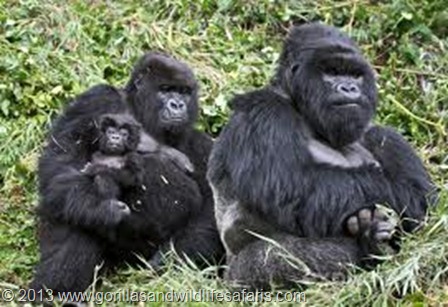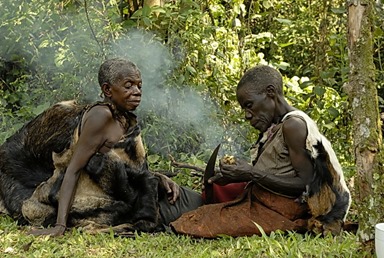As of January 2015, there are 10 habituated gorilla groups which are for tourism purposes, and these are the ones that gorilla trackers visit. At maximum 8 persons can visit each gorilla gorilla group per day spending a maximum one hour each visit. These groups include Susa group, Sabinyo, Amahoro, Group 13 (Agasha group), Kwitonda, Umubano, Bwengye, Hirwa, Karinsimbi, Ugenda.
In Rwanda, you can only track mountain gorilla in Volcanoes National Park (Parc National des Volcans), a part of the wider Virunga (mountains). At least 480 mountain gorillas inhabit this (Virunga) complex and live at altitudes ranging from 2,300-4,500 m ranging within the southern part of Virunga National Park (DRC), and the Volcanoes National Park northern Rwanda, while a few use the Mgahinga National Park, southwestern Uganda.
In Rwanda, Gorilla’s families or groups are divided into two those which are for the study/ research purposes and these are only accessed by scientists and researchers. These include: Beetsme, and Pablo’s Shida’s and have the largest number of individuals.
There are then also 10 habituated gorilla groups which are for tourism purposes, and these are the ones that gorilla trackers visit. At maximum 8 persons can visit each gorilla gorilla group per day spending a maximum one hour each visit. These groups include Susa group, Sabinyo, Amahoro, Group 13 (Agasha group), Kwitonda, Umubano, Bwengye, Hirwa, Karinsimbi, Ugenda.
1. Susa Group (Susa A Family) - the gorilla group that was famously studied by Dian Fossey.
It derives its name from the Susa River which flows through their home range. This family is the hardest to trek as it tends to range high into the mountains but RDB’s Tourism & Conservation trackers will know well in advance where the group is located the day before in advance for the next trackers. Sometimes tourists have been barred from tracking the group because of its distant location. This group is very impressive with a family size now of 28 gorilla members with 3 Silverbacks. It was the largest gorilla group before it split into two. The group had 42 individuals and when one visited it, all you could see where Gorillas all over. The group is well known for the young twins named Byishimo & Impano who are very playful. It also contains one of the oldest known habituated gorillas, Poppy. Born in 1976 Poppy is believed to be from one of Dian Fossey's original gorilla groups.
with 3 Silverbacks. It was the largest gorilla group before it split into two. The group had 42 individuals and when one visited it, all you could see where Gorillas all over. The group is well known for the young twins named Byishimo & Impano who are very playful. It also contains one of the oldest known habituated gorillas, Poppy. Born in 1976 Poppy is believed to be from one of Dian Fossey's original gorilla groups.
Typically, a mother abandons one of the twins, as it is almost impossible for her to care for both. As we watched the mother, Nyabitondore, care for the twins, Impano and Byishimo, at times we thought she would go insane from the task. But today you can enjoy the two bouncing around and playing as if nothing ever happened.
2. Karisimbi Family (Susa-B)
This is the family that split from the Original Susa (Susa-A) family and now it’s called Susa-B or Karisimbi Group. It contains 15 individuals and it always stays in the slopes of Karisimbi Volcano (4507M). which the highest pick of Rwanda. The Karisimbi Group is better suited to visits for more serious hikers. It appears that they have established their home range high up on the slopes of the Karisimbi caldera. Thus, a visit to this group may well end up as a full-days trek. The group sometimes migrates to higher altitude and hence makes tracking difficult. However, RDB tourism and conservation guides know where to find the group a day before. Tracking this gorilla family may sometimes be prohibited because of its distant location.
3. Sabyinyo Gorilla Group
Sabyinyo is an easily accessible group led by the powerful silverback Guhonda. Guhonda, the largest silverback of all the groups, who is well known for his massive physical appearance. Guhonda has kept his main challenger, Ryango, out of his group as a lonely silverback. There are fewer members within this family than in the other groups however they are equally impressive as a family.
The group was named after the Sabyinyo volcano which means "old man's teeth". Sabyinyo is one of the groups closest to the park's edge with 8 individuals: 1 Silverback (the biggest in the park); 3 Adult females; 1 Non adult female; 2 Juveniles and 1 Baby.
4. Amahoro Gorilla Group
Meaning "peaceful group", Amahoro, is the most peaceful of all the gorilla groups. The group has 17 individuals: 1 Silverback; 2 Blackbacks; 5 Adult females; 2 Sub adult males; 2 Juveniles and 5 Babies. However, peace comes at a price. Ubumwe, the group's silverback is so peaceful, easy going and calm, he has lost group members to Charles in the Umubano group.
To reach Amahoro one must endure a fairly steep climb however the climb is well worth it once in contact with this tranquil group.
5. Umubano Group
Meaning "neighborliness", Umubano a family of 11 individuals: 1 Silverback; 1 Sub adult male; 3 Adult females and 6 Babies.Umubano were originally Amahoro members but broke off after the dominant silverback (Ubumwe) was challenged by Charles, now the leader of Umubano.
As Charles matured into a silverback of the same rank as Ubumwe, he could not stand being given orders and decided to stage a fight and challenge Ubumwe. The fight went on for weeks and then months. Finally, Charles managed to snatch from Ubumwe a few females and formed his own group; thus Umubano was formed. Since then, he has commanded respect and recognition from Ubumwe. We have observed, on various occasions, interactions between the two silverbacks, but no fighting has been seen since the great battle ended.
6. 13 Group (aka Agasha Group)
When first habituated this group had only 13 members hence its name. Now the group has approximately 25 members: 1 Silverback; 12 Adult females; 2 Sub adult female; 3 Juvenile and 7 Babies. Formerly this group was commanded by Nyakarima who was challenged by Agashya meaning "the news". Agashya indeed made news by first watching and estimating Nyakarima's strengths and eventually challenging him to a fierce fight by taking off with his whole group. This was a shock to Nyakarima and an unprecedented event in observed gorilla history. Agashya then moved up the volcano to secure his group and make sure Nyakarima did not track them. Agashya has since increased his group's numbers by snatching from other groups and assimilating other lone gorillas, rapidly increasing the group from 12 to 25 individuals.
Agashya is known, at the first sign of trouble, to take his whole group up to the top of the volcano. Once, while we were taking a group of tourists to see Group 13 this exact scenario unfolded. Agashya felt that there was another silverback who was about to challenge him. In response, he took the group up the volcano. Every time we thought we were close to see them, Agashya would move the group further uphill. We did not reach them until the very top, where we finally got a chance to see them. By the time we got back to the car we had walked for 12 hours. While it was an exhausting day, it was magical to see gorillas at the top the world.
7. Kwitonda Family
This 18-member group is led by a silverback known as Kwitonda which means “humble one” and has two silverbacks and one blackback. Having migrated from DRC, this group tends to range far making it a moderately difficult trek. Together with Susa B this is one of the difficult groups to track
8. Hirwa Group (meaning "lucky one")
This group came into the lime light on the 17th of June 2006 when trackers witnessed its formation by the merging of some members from two different existing families, namely from Group 13 and Sabyinyo making a very small group then. As luck would have it, other gorillas joined the group and now Hirwa has 9 individuals: 1 Silverback; 3 Adult females; 2 Sub adult females and 3 Babies.
Despite being the newest group on the block, Hirwa exhibits strength and holds its own amongst all the other established groups.
9. Bwenge Family
The family size of this group is 11 individuals with Silverback. It is mostly found on the Slopes of the Karisoke Volcano. The group is led by a silverback named Bwenge and was formed in 2007 when he left his natal group and was gradually joined by females from other groups. This group has had some hard times; this is because there were some deaths of 6 infants. However now the group is growing strong with 2 successful births in the last few years and a strong capable silverback leader. The trek to see the group is tough and one has to hike up the hill or like 3 hours (gaining approximately 600m in elevation). The trails are sometimes muddy and very steep. Apparently it was also the group that was featured in the movie "Gorillas in the Mist".
10. Ugenda Family
This Group is found in Karisimbi area of Rwanda. The Family Size consists of 11 gorillas with 2 silverbacks. Its name means “being on the move” and was named because it was always moving from one area to another. Since it’s not in one place, tracking it may be some how difficult and involves also moving from one place to another to locate them.
Related articles:
Comparing Gorilla Trekking Tours : Uganda Vs Rwanda – Compare prices, experience, hardness,etc
When is the Best time for gorilla trekking/ tracking in Rwanda and Uganda?
2 days Gorilla tracking Rwanda with tour price
3 day Gorilla tracking Rwanda with tour price
Gorillas trekking and Chimps Rwanda - 4 days tour




